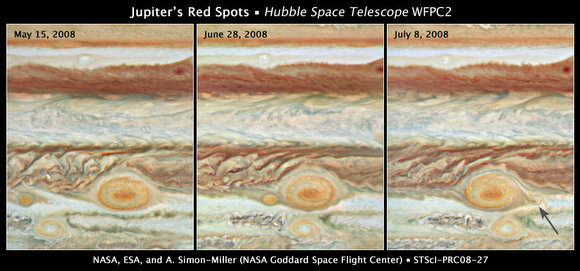The Great Red Spot on Jupiter has been observed for over 150 years, and it doesn’t appear this anti-cyclonic storm is showing any signs of letting up. How does it maintain its power? Well, like a planetary Pac-Man, it “eats up” other storms, zapping them of their power. The sequence of images here from the Hubble Space Telescope shows three different storms on Jupiter: The Great Red Spot, Red Spot Jr. (otherwise known as Oval BA, to the south of GRS), and Baby Red Spot, to the left of GRS in the first two images. Baby got a little too close to big brother GRS, and may have been snuffed out. But GRS keeps on keeping on. These three natural-color Jupiter images were made from data acquired on May 15, June 28, and July 8, 2008, by the Hubble’s Wide Field Planetary Camera 2.
Red Spot Jr. first appeared on Jupiter in early 2006 when a previously white storm turned red. This is the second time, since turning red, it has skirted past its big brother apparently unscathed. More on Jr. or Oval BA over at the BA himself, Phil Plait’s Bad Astronomy.
But poor little Baby Red Spot, which is in the same latitudinal band as the GRS. This new red spot first appeared earlier this year. The baby spot gets ever closer to the GRS in this picture sequence until it is caught up in GRS’s anticyclonic spin. In the final image the baby spot is deformed and pale in color and has been spun to the right (east) of the GRS. The prediction is that the baby spot will now get pulled back into the GRS “Cuisinart” and disappear for good. This is one possible mechanism that has powered and sustained the GRS for at least 150 years.
Each image covers 58 degrees of Jovian latitude and 70 degrees of longitude (centered on 5 degrees South latitude and 110, 121, and 121.
Original News Source: HubbleSite


I wonder if the co-incidence of Baby Red Spot, Red Spot Jr. and GRS all lining up at one may have led to BRS slowing down. It appears that GRS and RSJ turn in the same direction and if BRS passed between them the left hand pull from GRS and right hand pull from RSJ may have slowed BRS down enough to have it pulled into the GRS. This may have caused it capture but I wonder how much energy the GRS would have captured from a “slowed-down” BRS and how frequently such a capture would happen.
It’s amazing that those images were captured by Hubble.
I think the Great Red Spot is caused by a solid feature deep under the atmosphere causing gases to well up and form a persistent “storm.” Jupiter has been sucking in asteroids, comets, and probably a moon or two over a long period of time. It’s possible that the solid material is floating in gas that has been liquified under tremendous pressure. If true, then the GRS should eventually disappear as Jupiter’s winds/currents erode it away.
All three spots are fine as numerous amateur images taken after the last HST pic in the sequence have since demonstrated – the press release was quick but apparently off the mark …
The fact that a spot can apparently be destroyed, and still survive, supports the theory that some spots may be upwellings of gases caused by solid objects disrupting the flow of gas and liquid underneath the cloud surface. A spot could disappear – like disrupting a column of smoke by blowing through it – and once the disturbance (GRS in this case) is gone, then the missing spot will reform.